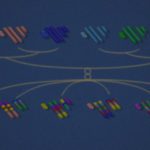Lien vers Pubmed [PMID] – 1939658
J. Clin. Invest. 1991 Nov; 88(5): 1730-6
A viable autosomal recessive mutation (named fch, or ferrochelatase deficiency) causing jaundice and anemia in mice arose in a mutagenesis experiment using ethylnitrosourea. Homozygotes (fch/fch) display a hemolytic anemia, photosensitivity, cholestasis, and severe hepatic dysfunction. Protoporphyrin is found at high concentration in erythrocytes, serum, and liver. Ferrochelatase activity in various tissues is 2.7-6.3% of normal. Heterozygotes (+/fch) are not anemic and have normal liver function; they are not sensitive to light exposure; ferrochelatase activity is 45-65% of normal. Southern blot analysis using a ferrochelatase cDNA probe reveals no gross deletion of the ferrochelatase gene. This is the first spontaneous form of erythropoietic protoporphyria in the house mouse. Despite the presence in the mouse of clinical and biochemical features infrequent in the human, this mutation may represent a model for the human disease, especially in its severe form.

